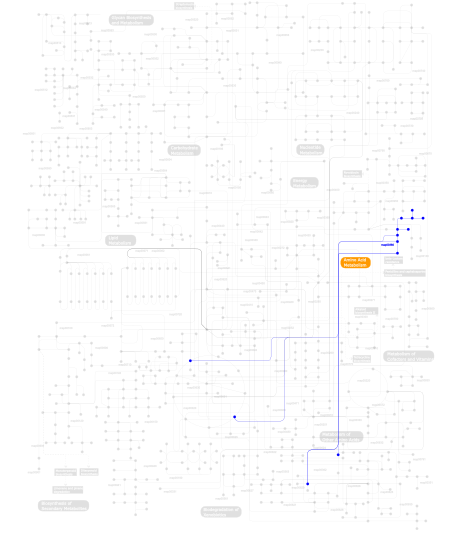The domain within your query sequence starts at position 638 and ends at position 695; the E-value for the RINGv domain shown below is 7.45e-22.
LCRICQIAGGSPANPLLEPCGCVGSLQFVHQECLKKWLKVKITSGADLGTVKTCEMCK
RINGvThe RING-variant domain is a C4HC3 zinc-finger like motif found in a number of cellular and viral proteins. Some of these proteins have been shown both in vivo and in vitro to have ubiquitin E3 ligase activity. |
|---|
| SMART accession number: | SM00744 |
|---|---|
| Description: | The RING-variant domain is reminiscent of both the RING and the PHD domains and may represent an evolutionary intermediate. To describe this domain the term PHD/LAP domain has been used in the past. Extended description: The RING-variant (RINGv) domain contains a C4HC3 zinc-finger-like motif similar to the PHD domain, while some of the spacing between the Cys/His residues follow a pattern somewhat closer to that found in the RING domain. The RINGv domain, similar to the RING, PHD and LIM domains, is thought to bind two zinc ions co-ordinated by the highly conserved Cys and His residues. RING variant domain: C-x (2) -C-x(10-45)-C-x (1) -C-x (7) -H-x(2)-C-x(11-25)-C-x(2)-C As opposed to a PHD: C-x(1-2) -C-x (7-13)-C-x(2-4)-C-x(4-5)-H-x(2)-C-x(10-21)-C-x(2)-C Classical RING domain: C-x (2) -C-x (9-39)-C-x(1-3)-H-x(2-3)-C-x(2)-C-x(4-48) -C-x(2)-C |
| Interpro abstract (IPR011016): | Zinc finger (Znf) domains are relatively small protein motifs which contain multiple finger-like protrusions that make tandem contacts with their target molecule. Some of these domains bind zinc, but many do not; instead binding other metals such as iron, or no metal at all. For example, some family members form salt bridges to stabilise the finger-like folds. They were first identified as a DNA-binding motif in transcription factor TFIIIA from Xenopus laevis (African clawed frog), however they are now recognised to bind DNA, RNA, protein and/or lipid substrates [ (PUBMED:10529348) (PUBMED:15963892) (PUBMED:15718139) (PUBMED:17210253) (PUBMED:12665246) ]. Their binding properties depend on the amino acid sequence of the finger domains and of the linker between fingers, as well as on the higher-order structures and the number of fingers. Znf domains are often found in clusters, where fingers can have different binding specificities. There are many superfamilies of Znf motifs, varying in both sequence and structure. They display considerable versatility in binding modes, even between members of the same class (e.g. some bind DNA, others protein), suggesting that Znf motifs are stable scaffolds that have evolved specialised functions. For example, Znf-containing proteins function in gene transcription, translation, mRNA trafficking, cytoskeleton organisation, epithelial development, cell adhesion, protein folding, chromatin remodelling and zinc sensing, to name but a few [ (PUBMED:11179890) ]. Zinc-binding motifs are stable structures, and they rarely undergo conformational changes upon binding their target. The RING finger is a well characterised zinc finger which coordinates two zinc atoms in a cross-braced manner. According to the pattern of cysteines and histidines three different subfamilies of RING finger can be defined. The classical RING finger (RING-HC) has a histidine at the fourth coordinating position and a cysteine at the fifth. In the RING-H2 variant, both the fourth and fifth positions are occupied by histidines. The RING-CH, which is very similar to the classical RING finger, differs from both of these variants in that it has a cys residue in the fourth position and a His in the fifth. Another difference between the RING-CH and the common RING variants is a somewhat longer peptide segment between the fourth and fifth zinc-coordinating residues. The RING-CH zinc finger has thus the same arrangement of cysteine and histidine (C4HC3) as the PHD zinc finger but it contains features (spacing between the cysteines and the histidine) characteristic of the genuine RING-finger (C3HC4) [ (PUBMED:11641273) (PUBMED:12695663) ]. The RING-CH-type is an E3 ligase mainly found in proteins associated to membranes [ (PUBMED:16873052) (PUBMED:17051211) ]. The solution structure of the RING-CH-type zinc finger of the herpesvirus Mir1 protein has shown that it is an outlying relative of the cellular RING finger domain family, with its polypeptide backbone much more closely resembling that of RING domains than PHD domains [ (PUBMED:15465811) ]. The only real difference between the classic and variant RING domains, other than the alteration of zinc ligands, is the loss of the small beta-sheet found in RING domains and the replacement of one strand of this sheet with a single turn of helix. Some proteins that contains a RING-CH-type zinc finger are listed below:
|
| GO function: | zinc ion binding (GO:0008270) |
| Family alignment: |
There are 12153 RINGv domains in 12134 proteins in SMART's nrdb database.
Click on the following links for more information.
- Evolution (species in which this domain is found)
- Cellular role (predicted cellular role)
- Literature (relevant references for this domain)
- Metabolism (metabolic pathways involving proteins which contain this domain)
- Structure (3D structures containing this domain)
- Links (links to other resources describing this domain)






